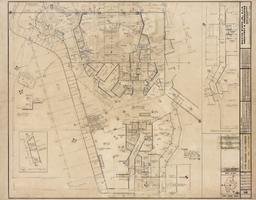Search the Special Collections and Archives Portal
Search Results

Architectural drawing of Sands Hotel (Las Vegas) additions and alterations, ultimate development plan,tower shadow projection study, February 4, 1964
Date
Archival Collection
Description
Architectural plans for proposed additions and alterations to The Sands. Printed on mylar. Notes indicate at what times of the day and year the pool area is clear of shadows. Berton Charles Severson, architect; Brian Walter Webb, architect; Frank R. Bernard, delineator.
Site Name: Sands Hotel
Address: 3355 Las Vegas Boulevard South
Image

Architectural drawing of Sands Hotel (Las Vegas) additions and alterations, ultimate development plan, construction phasing plan and notes, August 3, 1964
Date
Archival Collection
Description
Architectural plans for proposed additions and alterations to The Sands. Printed on mylar. Includes notes and schedule of construction projects. Berton Charles Severson, architect; Brian Walter Webb, architect; Bruce Johnson, delineator.
Site Name: Sands Hotel
Address: 3355 Las Vegas Boulevard South
Text

Architectural drawing of Sands Hotel (Las Vegas) additions and alterations, ultimate development plan, existing facilities, second floor plan, August 3, 1964
Date
Archival Collection
Description
Architectural plans for proposed additions and alterations to The Sands. Printed on mylar. Berton Charles Severson, architect; Brian Walter Webb; architect; Milton R. Bertrand, delineator.
Site Name: Sands Hotel
Address: 3355 Las Vegas Boulevard South
Image

Architectural drawing of Sands Hotel (Las Vegas) additions and alterations, ultimate development plan, demolition plan and notes, August 3, 1964
Date
Archival Collection
Description
Architectural plans for proposed additions and alterations to The Sands. Printed on mylar. Shows portions of the main bulding to be demolished and relocation sites for existing outbuildings. Berton Charles Severson, architect; Brian Walter Webb; architect; Milton R. Bertrand, delineator.
Site Name: Sands Hotel
Address: 3355 Las Vegas Boulevard South
Image

Architectural drawing of Sands Hotel (Las Vegas) additions and alterations, first floor master plan, November 13, 1968
Date
Archival Collection
Description
Architectural plans for additions and alterations to The Sands. Berton Charles Severson, architect; Brian Walter Webb, architect; Masyoshi Tokubo, delineator; Martin Stern, Jr.; A.I.A. Architect & Associates.
Site Name: Sands Hotel
Address: 3355 Las Vegas Boulevard South
Image

Architectural drawing of Sands Hotel (Las Vegas), additions and alterations, second floor, master plan, November 13, 1968
Date
Archival Collection
Description
Second floor master plan for additions and alterations to the Sands Hotel; printed on mylar. Berton Charles Severson, architect; Brian Walter Webb, architect; Masyoshi Tokubo, delineator.
Site Name: Sands Hotel
Address: 3355 Las Vegas Boulevard South
Image

Architectural drawing of Sands Hotel (Las Vegas), additions and alterations, master plan, control dimension plan, August 3, 1964
Date
Archival Collection
Description
Master plan control dimension plan for additions and alterations to the Sands Hotel, Las Vegas. Printed on mylar. Includes notes, revisions, and key plan. Berton Charles Severson, architect; Brian Walter Webb, architect; Dan Ford, delineator.
Site Name: Sands Hotel
Address: 3355 Las Vegas Boulevard South
Image

Architectural drawing of Sands Hotel (Las Vegas), additions and alterations, master plan, roof plan, August 3, 1964
Date
Archival Collection
Description
Master plan for the roof plan as part of the additions and alterations of the Sands Hotel, Las Vegas. Printed on mylar. Includes roof specifications, revisions, and notes for the promenade roof plan. Berton Charles Severson, architect; Brian Walter Webb, architect; Dan Ford, delineator.
Site Name: Sands Hotel
Address: 3355 Las Vegas Boulevard South
Image

Architectural drawing of Sands Hotel (Las Vegas), additions and alterations, partial first floor plan, August 3, 1964
Date
Archival Collection
Description
Architectural plans for additions and alterations to The Sands. Includes general floor plan notes, key plan, revisions, and symbol legend. Printed on mylar. Berton Charles Severson, architect; Brian Walter Webb, architect; J. Rock, delineator.
Site Name: Sands Hotel
Address: 3355 Las Vegas Boulevard South
Image

Architectural drawing of Sands Hotel (Las Vegas), additions and alterations, partial first floor plan, hotel lobby, August 3, 1964
Date
Archival Collection
Description
Architectural plans for additions and alterations to The Sands. Includes revisions and first floor key plan. Printed on mylar. Berton Charles Severson, architect; Brian Walter Webb, architect; William Pelkus, delineator.
Site Name: Sands Hotel
Address: 3355 Las Vegas Boulevard South
Image
